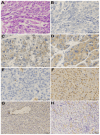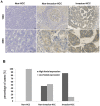Embryonic morphogen nodal is associated with progression and poor prognosis of hepatocellular carcinoma
- PMID: 24465741
- PMCID: PMC3897529
- DOI: 10.1371/journal.pone.0085840
Embryonic morphogen nodal is associated with progression and poor prognosis of hepatocellular carcinoma
Abstract
Background: Nodal, a TGF-β-related embryonic morphogen, is involved in multiple biologic processes. However, the expression of Nodal in hepatocellular carcinoma (HCC) and its correlation with tumor angiogenesis, epithelial-mesenchymal transition, and prognosis is unclear.
Methods: We used real-time PCR and Western blotting to investigate Nodal expression in 6 HCC cell lines and 1 normal liver cell line, 16 pairs of tumor and corresponding paracarcinomatous tissues from HCC patients. Immunohistochemistry was performed to examine Nodal expression in HCC and corresponding paracarcinomatous tissues from 96 patients. CD34 and Vimentin were only examined in HCC tissues of patients mentioned above. Nodal gene was silenced by shRNA in MHCC97H and HCCLM3 cell lines, and cell migration and invasion were detected. Statistical analyses were applied to evaluate the prognostic value and associations of Nodal expression with clinical parameters.
Results: Nodal expression was detected in HCC cell lines with high metastatic potential alone. Nodal expression is up-regulated in HCC tissues compared with paracarcinomatous and normal liver tissues. Nodal protein was expressed in 70 of the 96 (72.9%) HCC tumors, and was associated with vascular invasion (P = 0.000), status of metastasis (P = 0.004), AFP (P = 0.049), ICGR15 (indocyanine green retention rate at 15 min) (P = 0.010) and tumor size (P = 0.000). High Nodal expression was positively correlated with high MVD (microvessal density) (P = 0.006), but not with Vimentin expression (P = 0.053). Significantly fewer migrated and invaded cells were seen in shRNA group compared with blank group and negative control group (P<0.05). High Nodal expression was found to be an independent factor for predicting overall survival of HCC.
Conclusions: Our study demonstrated that Nodal expression is associated with aggressive characteristics of HCC. Its aberrant expression may be a predictive factor of unfavorable prognosis for HCC after surgery.
Conflict of interest statement
Figures







Similar articles
-
[Expression of Nodal in hepatocellular carcinoma and its relationship with angiogenesis and epithelial-mesenchymal transition].Zhonghua Wai Ke Za Zhi. 2014 Mar;52(3):188-92. Zhonghua Wai Ke Za Zhi. 2014. PMID: 24785457 Chinese.
-
MTBP Promotes the Invasion and Metastasis of Hepatocellular Carcinoma by Enhancing the MDM2-Mediated Degradation of E-Cadherin.Dig Dis Sci. 2015 Dec;60(12):3681-90. doi: 10.1007/s10620-015-3824-4. Epub 2015 Aug 18. Dig Dis Sci. 2015. PMID: 26280083
-
Role of IQGAP3 in metastasis and epithelial-mesenchymal transition in human hepatocellular carcinoma.J Transl Med. 2017 Aug 15;15(1):176. doi: 10.1186/s12967-017-1275-8. J Transl Med. 2017. PMID: 28810875 Free PMC article.
-
Fibulin-5 inhibits hepatocellular carcinoma cell migration and invasion by down-regulating matrix metalloproteinase-7 expression.BMC Cancer. 2014 Dec 12;14:938. doi: 10.1186/1471-2407-14-938. BMC Cancer. 2014. PMID: 25494879 Free PMC article.
-
Nodal expression and detection in cancer: experience and challenges.Cancer Res. 2012 Apr 15;72(8):1915-20. doi: 10.1158/0008-5472.CAN-11-3419. Cancer Res. 2012. PMID: 22508696 Free PMC article. Review.
Cited by
-
Expression and significance of Nodal in human cancers: a meta-analysis.Int J Clin Exp Med. 2015 Nov 15;8(11):20227-35. eCollection 2015. Int J Clin Exp Med. 2015. PMID: 26884935 Free PMC article.
-
Hydrocortisone Suppresses Early Paraneoplastic Inflammation And Angiogenesis To Attenuate Early Hepatocellular Carcinoma Progression In Rats.Onco Targets Ther. 2019 Nov 8;12:9481-9493. doi: 10.2147/OTT.S224618. eCollection 2019. Onco Targets Ther. 2019. PMID: 31807025 Free PMC article.
-
Biological effects of NODAL on endometrial cancer cells and its underlying mechanisms.Exp Ther Med. 2021 Apr;21(4):402. doi: 10.3892/etm.2021.9833. Epub 2021 Feb 25. Exp Ther Med. 2021. PMID: 33717261 Free PMC article.
-
Embryonic protein NODAL regulates the breast tumor microenvironment by reprogramming cancer-derived secretomes.Neoplasia. 2021 Apr;23(4):375-390. doi: 10.1016/j.neo.2021.02.004. Epub 2021 Mar 27. Neoplasia. 2021. PMID: 33784590 Free PMC article.
-
MicroRNA-9 exerts antitumor effects on hepatocellular carcinoma progression by targeting HMGA2.FEBS Open Bio. 2019 Oct;9(10):1784-1797. doi: 10.1002/2211-5463.12716. Epub 2019 Sep 20. FEBS Open Bio. 2019. PMID: 31408273 Free PMC article.
References
-
- Jemal A, Bray F, Center MM, Ferlay J, Ward E, et al. (2011) Global cancer statistics. CA Cancer J Clin 61: 69–90. - PubMed
-
- Forner A, Llovet JM, Bruix J (2012) Hepatocellular carcinoma. Lancet 379: 1245–1255. - PubMed
-
- Conlon FL, Lyons KM, Takaesu N, Barth KS, Kispert A, et al. (1994) A primary requirement for nodal in the formation and maintenance of the primitive streak in the mouse. Development 120: 1919–1928. - PubMed
-
- Shen MM (2007) Nodal signaling: developmental roles and regulation. Development 134: 1023–1034. - PubMed
Publication types
MeSH terms
Substances
LinkOut - more resources
Full Text Sources
Other Literature Sources
Medical

